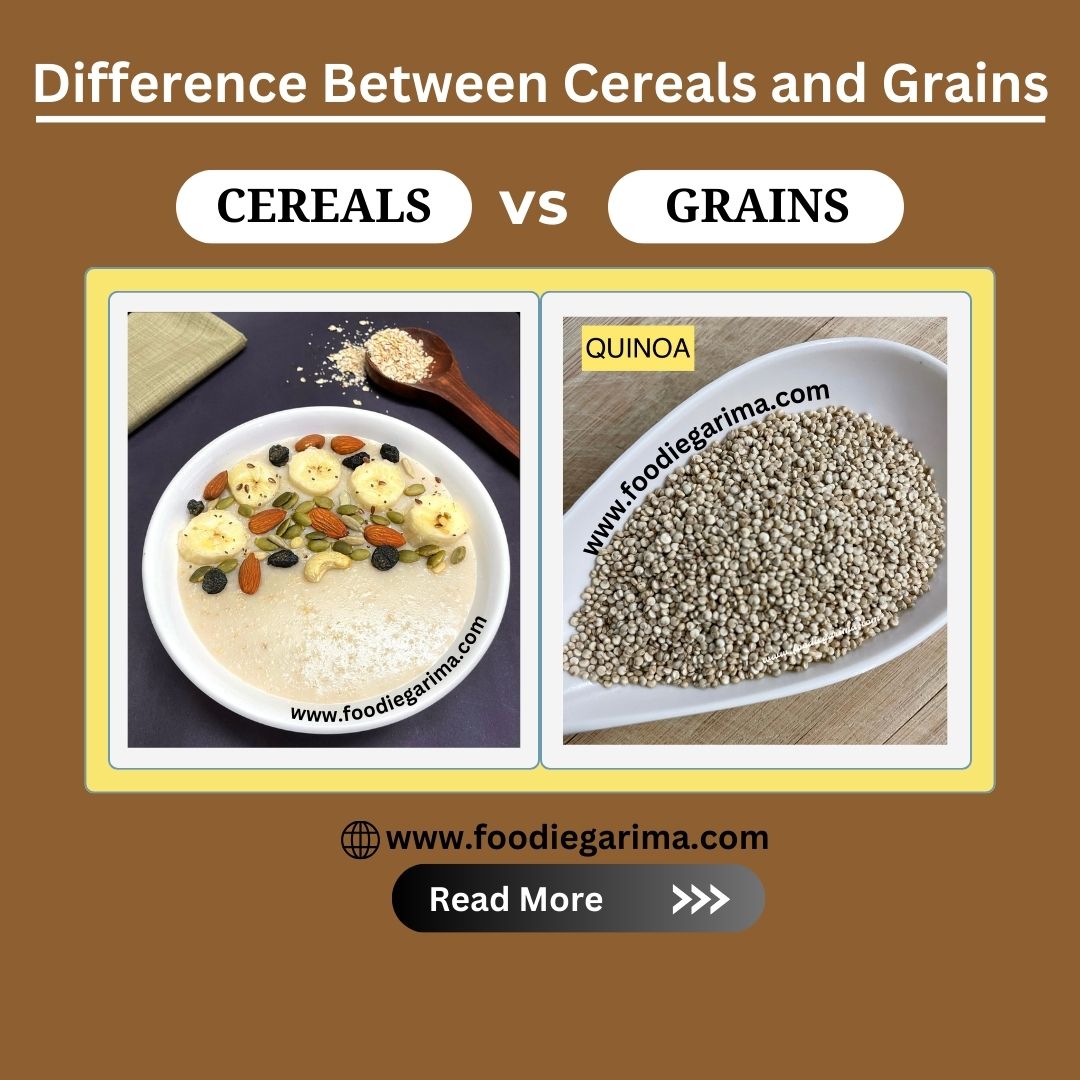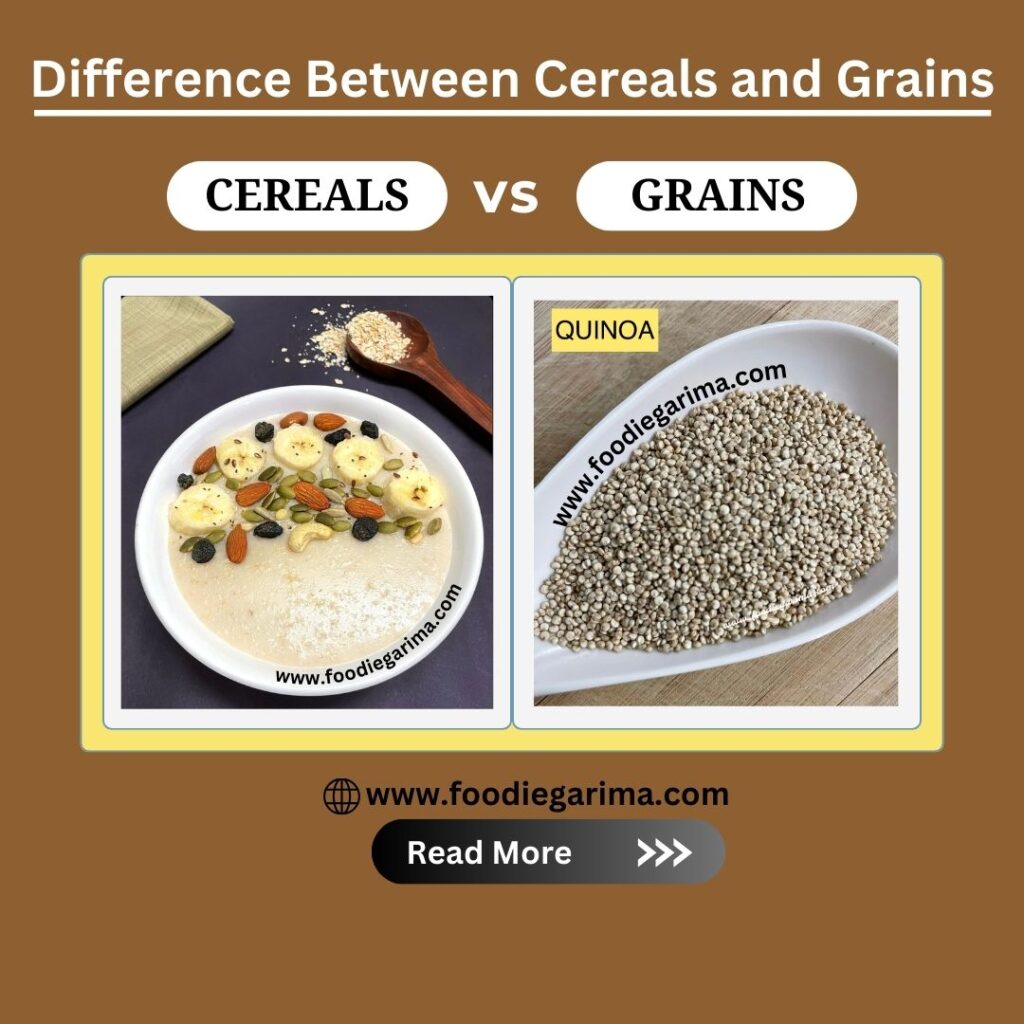7 January, 2025
Difference Between Cereals and Grains

Difference Between Cereals and Grains: Understanding the Basics
When discussing staple foods and nutrition, terms like “Cereals” and “Grains” are often used interchangeably. However, they are not exactly the same. Understanding the differences and overlaps between Cereals and Grains can provide clarity and enhance our appreciation of these essential food groups.
What Are Cereals?
Cereals are edible seeds or grains that come specifically from grasses belonging to the Poaceae family. These crops are cultivated primarily for their carbohydrate-rich seeds, which serve as a staple food source for much of the world’s population.
Examples of Cereals
- Rice
- Wheat
- Maize (Corn)
- Barley
- Oats
- Rye
- Sorghum
- Millet
Key Features of Cereals
- Source: Derived only from grass family plants (Poaceae).
- Usage: Typically processed into flour, flakes, or whole grains for human consumption.
- Nutritional Profile: Rich in carbohydrates, moderate protein, and varying amounts of fiber, vitamins, and minerals.
What Are Grains?
Grains refer to the small, hard, edible seeds of various plants, including Cereals. While Cereals are a subset of Grains, not all Grains are Cereals. For example, Pseudo-Cereals and Seeds from non-grass plants are also considered Grains.
Examples of Grains
- Cereals: Rice, wheat, maize, barley.
- Pseudo-Cereals: Quinoa, amaranth, buckwheat.
- Other Seeds: Chia seeds, flaxseeds.
Key Features of Grains
- Source: Includes seeds from grasses (cereals), non-grasses (pseudo-cereals), and other plants.
- Usage: Used in various forms such as whole, ground, or as flour.
- Nutritional Profile: Diverse, often higher in protein, fiber, and micronutrients than cereals alone.
While Cereals and Grains share similarities, their distinctions lie in their botanical origins and nutritional profiles. Cereals are a specific type of Grain derived from grasses, while Grains encompass a broader category, including Pseudo-Cereals and other edible Seeds. Incorporating a variety of Grains, including both Cereals and Pseudo-Cereals, ensures a balanced diet rich in nutrients and culinary diversity.
Differences Between Cereals and Grains
| Aspect | Cereals | Grains |
|---|---|---|
| Plant Family | Grasses (Poaceae) | Grasses, Pseudo-Cereals, and other Plants |
| Examples | Rice, Wheat, Maize | Cereals, Quinoa, Chia Seeds, Flaxseeds |
| Nutritional Focus | High in Carbohydrates, moderate Protein | Varied; often richer in Protein and Fiber |
| Gluten-Free Options | Some (e.g., Rice, Maize) | More (e.g., Quinoa, Buckwheat) |
| Culinary Use | Staples like bread, pasta, porridge | Wider use in salads, baking, and more |
Overlap Between Cereals and Grains
While Cereals are a subset of Grains, the broader term “Grains” encompasses:
- True Cereals: Seeds from grass plants.
- Pseudo-Cereals: Seeds from non-grass plants like quinoa and amaranth.
- Other Edible Seeds: Flaxseeds, chia seeds, and more.
Culinary Uses
- Cereals: Form the base for bread, rice dishes, breakfast cereals, and porridges.
- Grains: Broader applications including salads (quinoa), baked goods (buckwheat flour), and snacks (popped amaranth).
Nutritional Comparison
Cereals:
- Excellent energy source due to high carbohydrate content.
- Provide moderate protein and essential B-vitamins.
- Often fortified to enhance their nutritional value.
Grains:
- Include a wider variety of nutrients, especially protein and fiber.
- Many pseudo-cereals are complete proteins, containing all essential amino acids.
- Rich in antioxidants and micronutrients like magnesium and iron.
FAQs
1. Are all Cereals Grains?
Yes, all Cereals are Grains, but not all Grains are Cereals.
2. What are Pseudo-Cereals?
Pseudo-Cereals are seeds from non-grass plants, such as quinoa and buckwheat, that are used like cereals.
3. Are Grains healthier than Cereals?
Grains, including Pseudo-Cereals, often have a broader nutritional profile, but both are essential for a balanced diet.
4. Are Cereals gluten-free?
Some Cereals, like rice and maize, are naturally gluten-free, but others like wheat contain gluten.
5. Can Pseudo-Cereals replace Cereals?
Yes, Pseudo-Cereals can substitute Cereals in most recipes, especially for gluten-free diets.

Difference Between Cereals and Grains